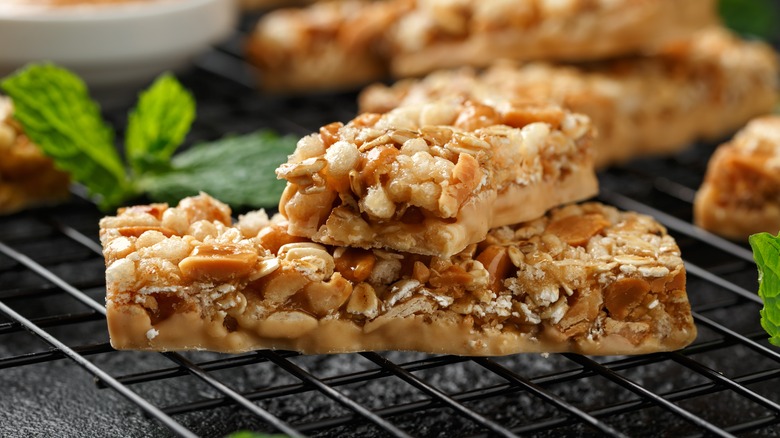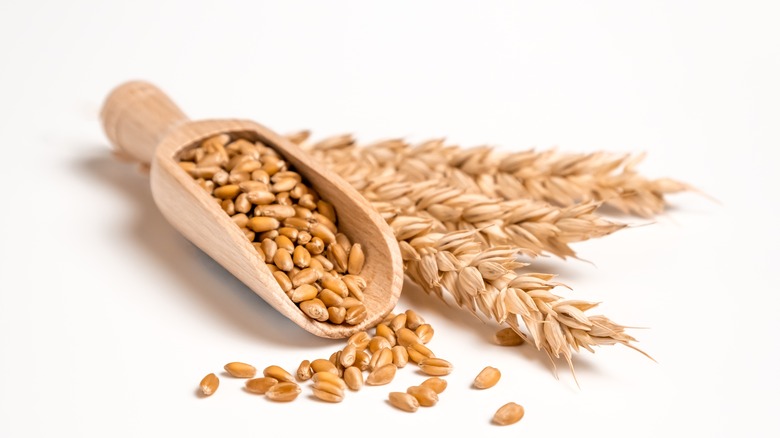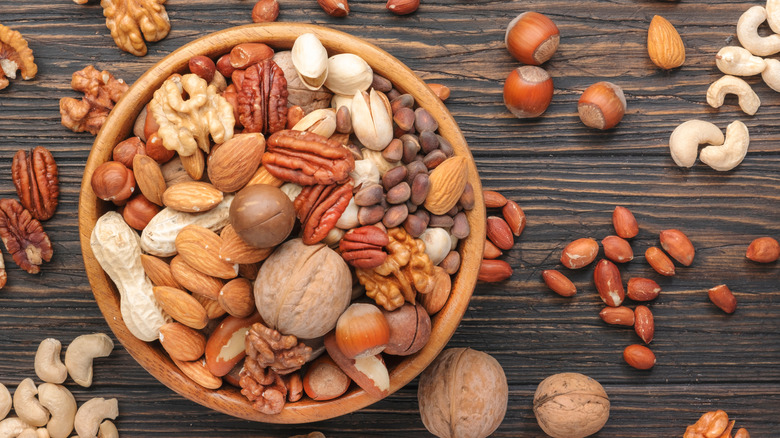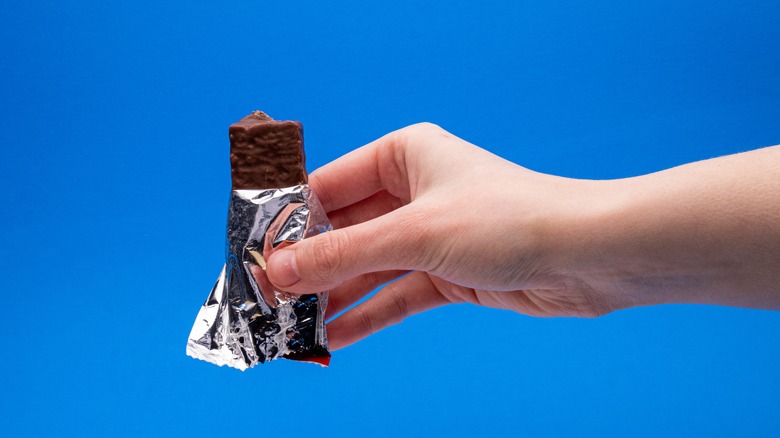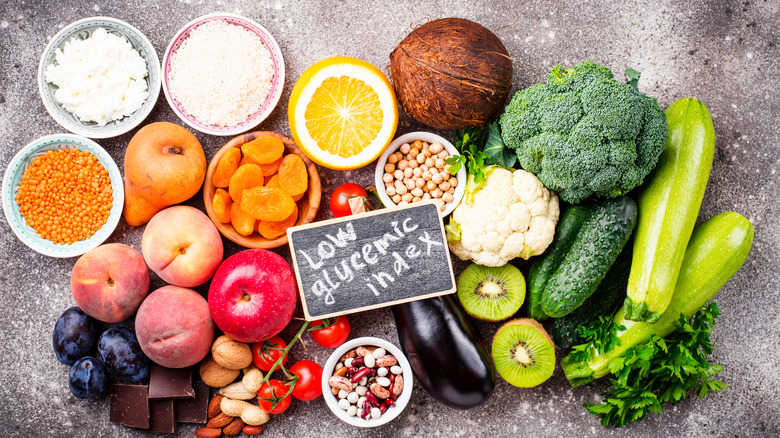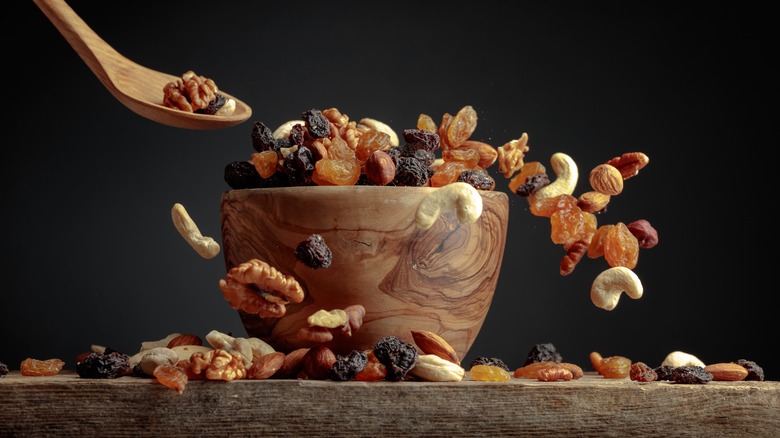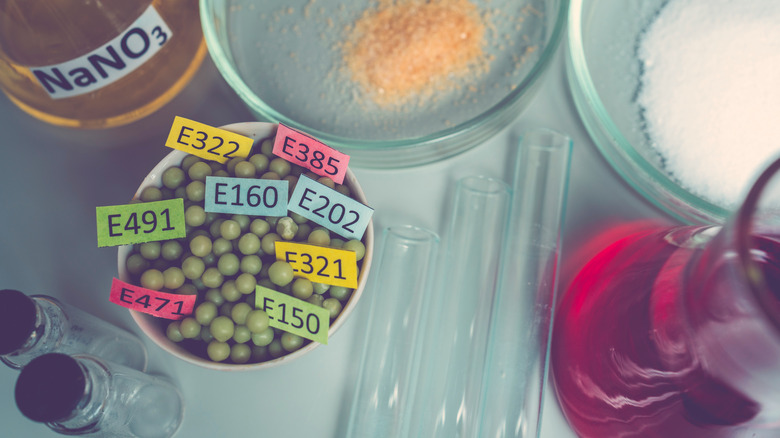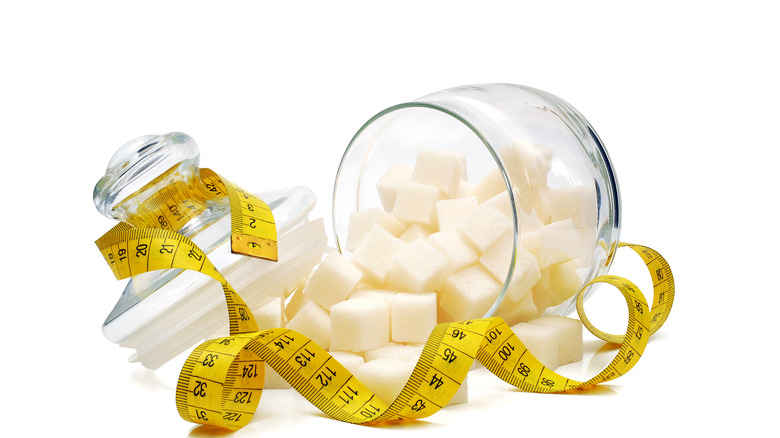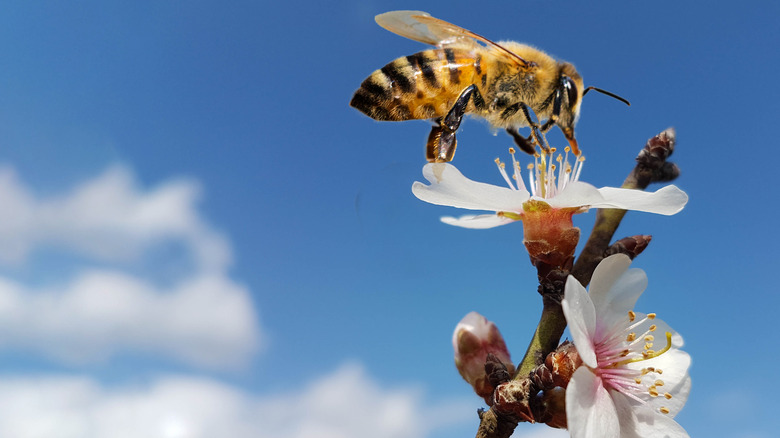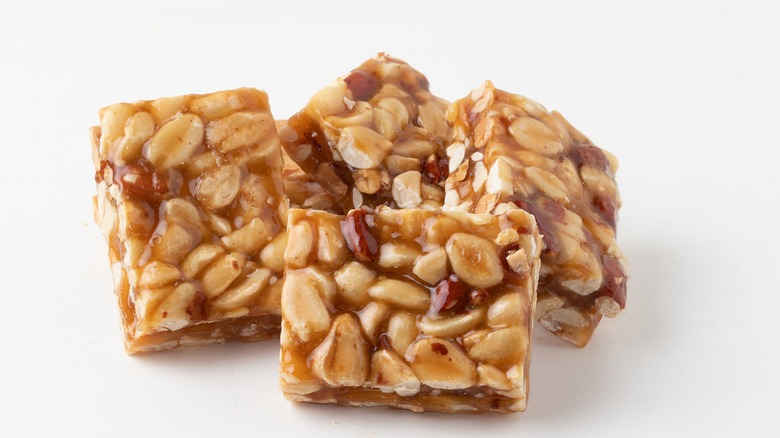Are KIND Bars Really Healthy?
Since their introduction in 2004, KIND bars have taken the snack bar market by storm. You can pick up a box in the grocery store, grab a single bar in the checkout line, or order them online. The marketing strategy for KIND bars bills them as a healthy alternative to the granola bars like the Quaker Oats bars you (probably) grew up on. The founder of KIND bars developed them to fulfill his own quest for a snack food that was "both nutritious and delicious" (per KIND Snacks). But are these bars actually healthy?
That depends on your definition of healthy. KIND bars have a lot going for them: They are made from real foods like oats and nuts, provide protein and fiber, and never contain artificial sweeteners or food dyes. But despite their high-quality ingredients, KIND bars are still snack bars. They are sweetened, even if it is with healthier sources of sugar, and some varieties are high in fat. But life is full of choices, and luckily, KIND bars provide buyers with many. Let's dig in further.
KIND bars are a good source of fiber
KIND bars are made with whole grains, making them a good source of fiber. Each flavor contains different ingredients, but KIND bars may include oats, amaranth, buckwheat, millet, and quinoa, which are all high-fiber whole grains. Fiber provides a slew of health benefits (per the Mayo Clinic). You probably already know that fiber keeps you regular, but you might not know why. Dietary fiber absorbs water, which makes your poop just the right consistency: not too watery, but not hard to pass. Fiber keeps your colon healthy in other ways by lowering your risk of hemorrhoids, diverticular disease, and colon cancer.
But the benefits of fiber extend beyond your gut. Fiber lowers cholesterol levels, stabilizes blood sugar levels, and helps you maintain a healthy weight. Because fiber promotes overall health, it reduces your risk of dying from cardiovascular disease as well as all types of cancer.
The U.S. Food & Drug Administration (FDA) has come out against the labels on KIND bars, saying that while they meet the definition of a good source of fiber, they don't meet the FDA standard of "healthy" — and therefore shouldn't claim to be such on the label (per Consumer Reports). Some varieties have too much fat (more than 3 grams of fat per serving) to meet the FDA requirements. KIND argues, however, that the fat in KIND bars is a healthy fat that comes from nuts and coconut.
KIND bars are a good source of protein
Protein is an essential component of any healthy diet. You might think of protein as something you need to build big muscles — and that's true — but you need protein for much more than that. According to the Harvard T.H. Chan School of Public Health, your body relies on protein for the structure of your cells, tissues, and organs. Proteins also carry out the chemical reactions in your body that keep you going and perform important functions like transporting oxygen in your blood. The daily protein requirement for an adult is based on weight — for every 20 pounds you weigh, you should take in 7 grams of protein.
Many people think of meat first when they think of protein sources, but plants can also serve as a good source of protein. In fact, nuts and other plant-based proteins like beans and soy products are often healthier sources of protein than animal products. Research has shown that replacing red meat with nuts, whole grains, or low-fat dairy was associated with reduced risk of type 2 diabetes, and replacing red meat with healthy plant proteins reduces risk factors for cardiovascular disease.
Because KIND bars are made with nuts and whole grains, they can be a good source of protein. According to Healthline, many varieties of KIND bars, like KIND Protein Dark Chocolate Nut bars, provide about 12 grams of protein per serving. Other bars, like the KIND Healthy Grains Dark Chocolate Peanut Butter bar, have only 2 grams of protein, so be mindful when choosing.
KIND bars are portion-controlled
According to the Centers for Disease Control and Prevention (CDC), portion control is one of the biggest pitfalls for people who are trying to lose or maintain weight. Portion sizes in America have crept up over time, which means American are eating more and more without necessarily realizing it. The truth is, most of us eat whatever is put in front of us, at home or in a restaurant. If you open a bag of chips or a nutrition bar, you will probably eat the whole thing, no matter how big or small it is. And if you sit down with an open container of roasted nuts, all bets are off.
KIND bars are portion-controlled, which can help prevent overeating. Most of the standard KIND bars clock in at between 150 to 250 calories, which is just the right amount for a snack, according to the Harvard T.H. Chan School of Public Health. KIND Minis and KIND Thins have either 90 or 100 calories if you are looking for a lighter snack. While it's easy to eat nuts by the handful, you probably won't reach in the box and open more than one KIND bar. Choosing an individually wrapped bar with a healthy number of calories provides easy portion control that can help prevent overeating and aid in weight loss.
KIND bars have a low glycemic index
The glycemic index (GI) is a way of measuring how certain foods affect blood glucose (a.k.a. blood sugar) levels (per Harvard Health Publishing). Foods with a low GI release glucose slowly, whereas foods with a high GI quickly release it. According to the Mayo Clinic, research shows that diets rich in low-GI foods help to stabilize blood sugar levels, which is especially important for people with diabetes. Low-GI diets can also help people lose weight, maintain weight, and lower their risk of developing diabetes or diseases of the heart or blood vessels.
Because KIND bars are made of ingredients that are naturally low on the GI scale, they have a low GI as well. Nuts are mainly protein, but even the carbohydrates in KIND bars rank low on the scale. Oats, for example, have a GI of 55 on a scale of 100 (per Harvard Health Publishing), apples have a GI of 36, and apple juice has a GI of 41. Many KIND bars use whole grains like oats and sweeteners like apple juice and pureed apples (per KIND Snacks), which keeps the total GI low.
KIND bars are made with real ingredients
A plant-based, whole food diet is all the rage right now, and for good reason. According to Healthline, this type of diet, which focuses on fresh ingredients and minimally processed foods, can help you lose weight while improving your health. People who follow a plant-based diet have a lower risk of heart disease, certain cancers (including gastrointestinal and colon cancers), diabetes, and cognitive decline.
While not entirely made from whole foods, KIND bars have a place in a plant-based, whole food diet. They are minimally processed — according to the KIND Promise, the first ingredient in its bars is always a nutrient-dense food such as a nut, whole grain, or fruit. When you look at KIND bars, you can see the whole almonds and pieces of dried fruit. However, they may also contain drizzled chocolate or salted caramel, hence the "processed" part of minimally processed. However, KIND bars never include high fructose corn syrup, artificial sweeteners, or sugar alcohols, so even the processed components are healthier than the ingredients found in many other nutrition bars and granola bars.
KIND bars never contain food dyes
Food dyes are some of the most common food additives, especially in foods marketed toward children. According to the FDA, food dyes, a.k.a. color additives, are found in frosting, popsicles, confections, cereals, and snack foods. That's not surprising — no one thinks Froot Loops grow on trees. But the FDA also approves food dyes for orange peels, yogurt, and crackers, foods that you might expect to be free of color additives.
Part of KIND Snack's commitment to using real food and recognizable ingredients in its bars is a commitment to leave out food dyes from its nutrition bars and other products. In fact, KIND discontinued its line of fruit snacks rather than reformulate them to compete with leading fruit snacks aimed at children (per Forbes). Its Fruit Bites were never made with color additives, only with real dried fruit, but did not sell well. The company realized that the snacks did not appeal to kids who were accustomed to brightly colored fake fruit snacks, but they chose not to compete rather than add dye to their product.
But what's so bad about food dyes? According to the Cleveland Clinic, there is a mixed verdict as to the safety of color additives, but some studies have linked them to hyperactivity, ADHD, irritability, depression, hives, asthma, and tumor growth. Since they provide no nutritional benefits, it's better to avoid them. When you buy KIND products, you never have to worry about hidden food dyes.
KIND bars are gluten-free
People have become increasingly aware of celiac disease and gluten intolerance in recent years. Gluten-free products used to be relegated to health food stores, but now you can find these products at every grocery store and many popular restaurant chains. This increased availability is welcomed by people with celiac disease and gluten intolerance who must follow a gluten-free diet.
According to the Cleveland Clinic, celiac disease is an autoimmune disease that affects the small intestine. People with this condition must avoid gluten-containing grains such as wheat, barley, and rye. If not, their immune system attacks their small intestine, causing symptoms such as stomachache, gas, constipation, and diarrhea. Over time, celiac disease causes serious malnutrition and intestinal damage. Gluten intolerance, or gluten sensitivity, also causes discomfort (though typically not as severe). Gluten intolerance causes many of the same digestive symptoms as celiac disease (per Medical News Today). It may also cause brain fog, confusion, numbness, joint or muscle pain, and a skin rash.
For people with these conditions, KIND bars are a no-brainer when it comes to choosing a protein bar or snack food. All KIND products, including KIND bars, granola, and other snack foods, are certified gluten-free, according to KIND. It can be hard to find gluten-free snack foods, especially when you are on the go. Many snack foods that you might expect to be gluten-free, like granola bars, use oats that may have been processed in a facility with wheat, making them unsuitable for people on a gluten-free diet due to potential cross-contamination. KIND bars provide a safe, healthy choice.
Some KIND bars contain a lot of added sugar
Processed food are often filled with added sugars, which has been linked to a variety of health problems. It's no surprise that consuming added sugar leads to weight gain (per Healthline), but you might be surprised to learn that studies have linked it to heart disease and acne. It can also increase your risk of developing type 2 diabetes and cancer. Added sugars are found in foods you expect to be sweet, like ice cream, but also in unexpected foods like pasta sauce and salad dressing.
Many varieties of KIND bars have added sugar, some more than others. According to information from KIND Snacks, some flavors, like KIND Nuts & Spices Madagascar Vanilla Almond, have as few as 2 grams of added sugar while others, such as KIND Simple Crunch Dark Chocolate & Oats bar, have as many as 9 grams of added sugar. Flavors like this provide almost 20% of the recommended daily value for added sugar, which is a lot for one small snack.
KIND has committed to offering varieties with reduced added sugar, according to a 2015 press release. The bars in its Fruit & Nut line have 15-20% less added sugar compared to the original recipe, and the bars in its Nuts & Spices line have 5 grams of sugar or less. If you are watching your sugar intake, there is a KIND bar for you. Just take the time to check the label.
KIND is committed to reducing its environmental impact
Our health depends on the world around us, including the purity of the water we drink and the cleanliness of the air we breathe. KIND is committed to practices that reduce its environmental footprint. By taking these steps, KIND makes its bars a little bit healthier.
According KIND snacks, the company committed to reducing its use of plastic by 25% by the year 2025. As of 2020, KIND already reduced its use of plastic by 17%. It continues to explore ways to reduce overall packaging and increase its use of recyclable, reusable, or compostable plastics, with a goal of using 100% reusable, recyclable, or compostable plastics by 2025. By decreasing total use of plastic and the amount of plastic that ends up in landfills, KINDS reduces its negative impact on the environment.
KIND is also stepping up its efforts to improve the environment by focusing on bee health. Bees are critical to the pollination of many plant species. Sadly, the widespread use of pesticides has caused bee populations to decrease. In the U.S., KIND only sources almonds from suppliers that do not use the two most harmful pesticides. In addition, KIND has committed to sourcing more than half of its almonds from bee-friendly farms by 2022 and 100% by 2025. "Bee-friendly" farms strive to counter the impact of modern farming by dedicating part of their land to pollinator habitats that are welcoming to bees, butterflies, and other pollinators.
Some KIND bars are high in fat
Though the fat content varies between varieties and flavors, some KIND bars are high in fat. In fact, some contain too much fat to qualify for the "healthy" label based on FDA requirements. The FDA label only allows manufacturers to label a food as "healthy" if it has 1 gram of saturated fat or less per serving, and no more than 15% of its total calories come from saturated fat (per Consumer Reports). The FDA actually sent KIND a letter telling the company to cease putting the healthy label on certain bars, including Fruit & Nut Almond & Apricot, Fruit & Nut Almond & Coconut, Kind Plus Peanut Butter Dark Chocolate + Protein, and Kind Plus Dark Chocolate Cherry Cashew + Antioxidants.
KIND counters that because the fat in its bars comes from nuts, it is healthy fat, and there is evidence supporting this claim. According to the Mayo Clinic, the fat in nuts is mostly monounsaturated and polyunsaturated fat that lowers bad cholesterol levels — though nuts do contain saturated fats as well (via British Heart Foundation). In addition, nuts like almonds contain omega-3 fatty acids, which play a role in reducing heart attack and strokes. If you are concerned about total fat consumption in your diet, look for KIND bars with lower fat content. For example, the Vanilla Blueberry KIND Healthy Grains bar has 0 grams of saturated fat per serving.
KIND bars are convenient
We've all been there: You're out of the house, starving, with no time to stop for a real meal. Picking up a hamburger at the drive through or grabbing a Snickers at the gas station would be quick and easy, but you know those are not good for you. Still, you have to eat. This is the perfect time for a KIND bar.
In a pinch, KIND bars are much healthier than a candy bar or anything you can get at McDonald's. They are plant-based, made with real ingredients, and much lower in fat or sugar than most other convenience foods. For example, a Snickers bar has 250 calories, 28 grams of sugar, 1 gram of dietary fiber, and 12 grams of fat, including 4.5 grams of saturated fat. In comparison, a KIND Healthy Grains Dark Chocolate Peanut Butter bar has 140 calories, 7 grams of sugar, 3 grams of dietary fiber, and just 6 grams of fat, including 2 grams of saturated fat.
KIND bars have a long shelf life, even though they do not have chemical additives to preserve them. It's not a bad idea to keep a few in your purse or gym bag to stave off hunger. While you might not want to make it a habit of replacing a meal with a KIND bar, it's a healthy solution every now and then.

